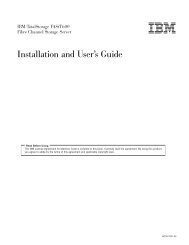Addressing OLTP Solutions with CICS: The Transaction Server ... - Ibm
Addressing OLTP Solutions with CICS: The Transaction Server ... - Ibm
Addressing OLTP Solutions with CICS: The Transaction Server ... - Ibm
Create successful ePaper yourself
Turn your PDF publications into a flip-book with our unique Google optimized e-Paper software.
<strong>The</strong> ANIMATOR debugging tool enables you to test a Micro Focus COBOL<br />
application program online <strong>with</strong>out modifying the program. This tool intercepts<br />
execution of the application program at various points before displaying<br />
information about the program. Any screens sent by the application program<br />
are displayed by the tools, so that you can converse <strong>with</strong> the application<br />
program during testing just as you would on the production system.<br />
<strong>The</strong> IBM Application Debugging Program provides the ability to debug IBM<br />
COBOL, C, or PL/I programs.<br />
<strong>The</strong>re are a number of new facilities to go <strong>with</strong> the debugging tool:<br />
• A <strong>CICS</strong>-supplied transaction, CDCN, that turns the debugging tool on and off<br />
• A regionwide attribute, AllowDebugging <strong>with</strong> settings yes and no, to control<br />
whether the debugging tool can be used <strong>with</strong>in the region.<br />
• Two transaction definitions (TD) entries:<br />
− DFHCDCN0 (for the <strong>CICS</strong>-supplied program)<br />
− DFHCDCN (for the <strong>CICS</strong>-supplied mapset)<br />
10.6.4 Using <strong>Transaction</strong>s to Call Your Program<br />
In <strong>CICS</strong>, the term transaction is used to describe a fundamental unit of work,<br />
consisting of one or more application programs, that is initiated by a single<br />
request. A transaction is identified by a transaction identifier (tranid), which is<br />
used to call your application program in the <strong>CICS</strong> run-time environment.<br />
Given that both the transaction and program are defined to <strong>CICS</strong>, you can use<br />
the cicsterm or cicsteld commands to run the transaction and therefore run your<br />
application program. <strong>The</strong> transaction is executed in the run-time environment<br />
under the control of <strong>CICS</strong>, which provides the services requested by each API<br />
command and dynamically changes the control parameters.<br />
10.7 Designing Efficient Applications<br />
10.7.1 <strong>CICS</strong> <strong>Transaction</strong> Design<br />
150 <strong>CICS</strong> for AIX as the <strong>Transaction</strong> <strong>Server</strong><br />
As in all design, there is a balance to be struck between the possibly conflicting<br />
requirements of performance, efficiency, ease of maintenance, productivity,<br />
readability of code, usability, standards, budgets, and schedules. <strong>The</strong> standards<br />
and guidelines of your organization, and the prioritization of design goals, will<br />
determine how much of this section you can apply in the applications you are<br />
developing. It is assumed here that you have already completed your system<br />
design to a logical level and are now trying to divide the application processing<br />
into <strong>CICS</strong> transactions and programs, its input and output into BMS maps, and<br />
its data into <strong>CICS</strong> data areas, files, temporary storage queues, and transient data<br />
queues.<br />
A primary consideration for online transactions is whether to design<br />
conversational or pseudo conversational transactions.
















